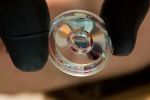
| regarding | user | just commented |
|---|---|---|
| A Tech Guide for the Newly Jobless | Ulyssus | If you invest in a good |
| New $US3 Light Bulb 12 Times More Efficient, Lasts 60 Years | Ulyssus | Saves having to frequently |
| Power Struggle | EdibK | It seems to me that you have |
| The Heat is on at the Tennis | Ulyssus | No doubt a few of the |
| Eyewitness Testimony Takes a Few More Hits | Highboy | Its scary when you see the |








